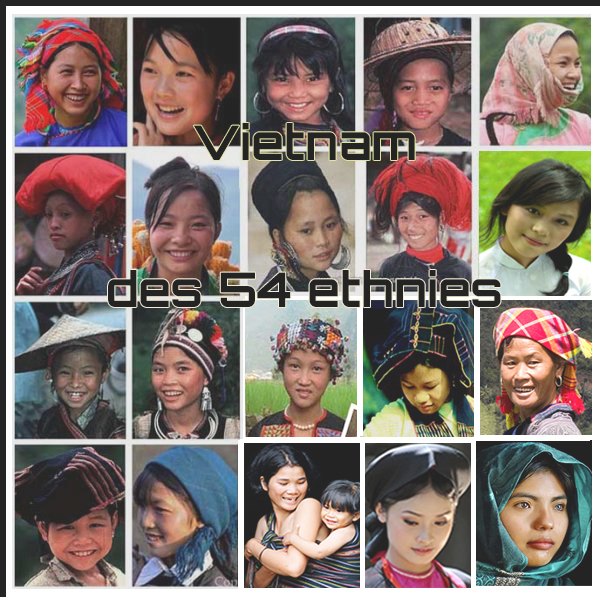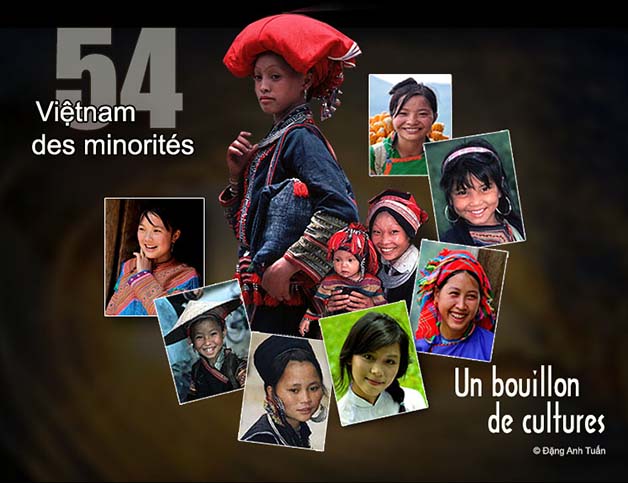Bầu ơi thương lấy bí cùng.
Tuy rằng khác giống nhưng chung một giàn.
Oh squash, you must be pitiful to pumpkin.
Despite the difference in species, you are on the same wire mesh.
In a very distant time, Vietnam consisted only of the Tonkin delta and the northern Annam plains. This vast area, sparsely populated and rich in natural resources, saw the development of daily life activities primarily based on wet rice cultivation. It is also here that, at the beginning of the 20th century, the French archaeologist Madeleine Colani discovered during archaeological excavations in 1922 the Hoà Bình culture (18000-10000 BC), which later gave rise to the Proto-Vietnamese civilization and the formation of the Vietnamese nation. To guard against the eternal threat from China, the latter had to find its salvation over the centuries by moving southward through the conquest of new lands (Champa, Chenla) and by applying a flexible policy towards the mountain minorities known as nhũ viên (ru yuan) since the founding of the nation with King Lý Thái Tổ.
This policy is effective insofar as it allows attracting minorities and uniting them under the authority of their leader against foreign invasions. That is why the immigration of minorities to Vietnam continued until the eve of the Second World War. Thus, we see the ingenious coexistence of these minorities with the Vietnamese (the Kinh) in a unified country skillfully governed by the Central Court. There have been several significant waves of migration initiated by these minorities over the centuries. First, the ethnic groups that arrived during the 2nd millennium AD include the Tày-Thaï, the Mon-Khmer, the Kadai, the Hmong-Yao, and the Tibetan-Burmese. The presence of the latter in Vietnam is explained by the fall of the Nan Zhao and Dali kingdoms in the 12th century in Yunnan (Vân Nam).
The arrival of the Thai in northwest Vietnam is part of their continuous exodus to Southeast Asia from the 9th to the 16th century. The Nùng (or the Choang) arrived in Vietnam after the fall of Nan Tian Guo (Nam Thiên Quốc) and the defeat of the prestigious leader Nùng Trí Cao in the 11th century. The Chinese were in Vietnam during the fall of the Ming in the 17th century and during the Sino-Japanese war. Immigration also came from the west. This is the case of the Khmou arriving from Laos after the failure of their uprising against the kingdom of Luang Prabang. Driven by Siamese and Laotian expansion, part of the Mon-Khmer settled in the Annamite mountain range (Trường Sơn) and on the Central Highlands (Tây Nguyên), etc. Once settled on this new land, these ethnic minorities preferred to stay and become the new citizens of Vietnam. Thus, today’s Vietnam has become a multiethnic nation. It extends from north to south over 1,650 km in length. There are 54 ethnic groups belonging to the following 8 language families:
- Viet-Muong Languages: 1) Viet (Kinh); 2) Muong; 3) Tho; 4) Chut
- Mon-Khmer Languages: 5) Khmer; 6) Ba Na (Bahnar); 7) Xo Dang (Sedang);8) Co Ho (K’ho); 9) Hre; 10) Mnong; 11) Stieng (Stieng);12) Brou-Van Kieu; 13) Co Tu (Katu); 14) Gie-Trieng (Jeh-Trieng); 15) Ma; 16) Kho Mu (Khmu); 17) Cor; 18) Ta Oi; 19) Cho Ro (Chro); 20) Khang; 21) Xinh Mun; 22) Mang; 23) Brau; 24) O Du; 25) Ro Mam (Rmam)
- Tay-Thai Languages (Tày Thai): 26) Tay; 27) Thai; 28) Nung; 29) San Chay; 30) Giay (Yay);31) Lao; 32) Lu; 33) Bo Y (Pu Y)
- Hmong-Yao Languages (Miao-Yao): 34 Hmong (Miao); 35 Yao; 36 Pa Then
- Kadai Languages: 37 La Chi (La ti); 38 La Ha; 39 Co Lao (Ge Lao); 40 Pu Peo
- Austronesian Languages: 41 Jarai; 42 Ê Đê (Rhade); 43 Cham; 44 Raglai; 45 Chu Ru
- Tibeto-Burman Languages: 46 Ha Nhi (Hani); 47 La Hu; 48 Phu La; 49 Lô Lô;50 Công; 51 Si La
- Sino-Tibetan Languages: 52 Hoa or Han (Chinese); 53 Ngai; 54 San Diu
- Formation of vietnamese ethnic groups (Sự thành hình của dân Bách Việt)
- The Bai Yue (Bách Việt)
- List of ethnic groups (in order of approximate population size)
- Costumes of ethnics minorities in Vietnam (Y phục)
- Museum of ethnography (Bảo tàng dân tộc học)
- The khène ou mouth organ (Khèn)
- The gongs of the Highlands (Cồng Chiêng Tây Nguyên)
- Houses of ethnic minorities in Vietnam (Nhà đồng bào thiểu số)
- Bahnar community house (Nhà Rông của dân tộc Bà Na)
- Jaraï funeral homes (Nhà mộ của người Gia Lai)
- Jean-Marie Duchange’s photos of the Vietnamese Highlands in the 1950s (Bộ ảnh của Jean Marie Duchange)
- Ethnic minority hoods (Gùi)
- The Tày stone stilt village (Nhà đá của người Tày)
- The Hmong (Dân tộc Hmong)
- The rainbow people (Dân tộc cầu vòng)
- Hmong women’s skirt (Váy của phụ nữ Hmong)
- Traditional costumes of ethnic minorities (Trang phục truyền thống của các dân tộc thiểu số)
- The Lôlô (Dân tộc Lôlô)
- The Mnong (Dân tộc Mnong)
- The Bahnar (Dân tộc Ba Na)
- The Mường (Dân tộc Mường)
- The Nùng (Dân tộc Nùng)
- The rebel Nùng Trí Cao, hero of the Nùng
- Superb photos at the women’s museum (Hanoï)
It is customary to plant squash and pumpkin in the corner of the garden on the same strip of land. Although they are vegetables of different species, they receive the same growing conditions. This proverb is meant to remind Vietnamese people that we live in a country with 54 ethnic groups. We live with other ethnic groups on the same land despite different material and spiritual living conditions. We are all the Children of the Dragon and the Great Children of the Immortal (Con Rồng Cháu Tiên). That is why we need to live together in good neighborliness and help each other in order to better build the great nation that Vietnam is today.
Vietnam des 54 ethnies


